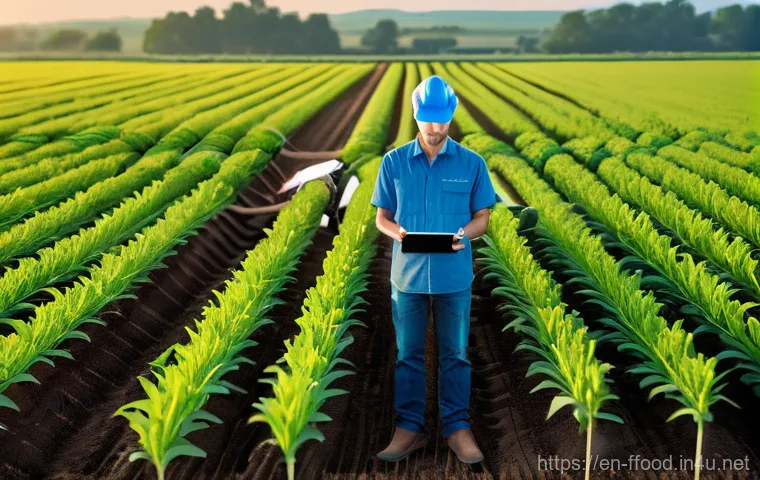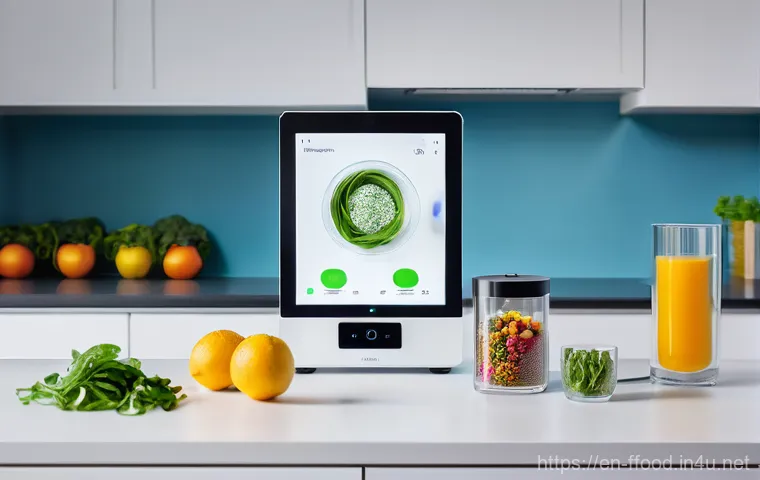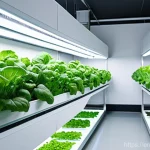It feels like every other day there’s a new headline about how technology is changing our world, right? Well, the kitchen, and indeed, our entire food system, is no exception!
I’ve been absolutely fascinated watching the incredible innovations bubbling up in “future food” – it’s so much more than just a passing trend; it’s a genuine revolution.
We’re talking about groundbreaking solutions that are not only making food more delicious and accessible but also tackling some of the planet’s biggest challenges, from sustainability to feeding a growing population.
When I first started diving into this, I honestly didn’t realize the sheer scope of what’s happening. From personalized nutrition to AI-powered farms and even entirely new ways of creating protein, these advancements are reshaping how we’ll eat for generations to come.
It’s an exciting time to be alive, and believe me, you’ll want to be in the know about what’s cooking next. Let’s dive into all the incredible details and understand exactly what these future food technologies mean for us!
The future of food is unfolding right before our eyes, and honestly, it’s nothing short of extraordinary! I’ve been keeping a close watch on all the innovations popping up, and it’s clear that we’re moving towards a world where our food isn’t just sustenance, but a powerful tool for health, sustainability, and tackling global challenges.
It’s a journey filled with exciting advancements, and I’m thrilled to share what’s truly cooking in this space.
Reimagining Protein: Beyond Traditional Sources

Okay, let’s talk protein. For so long, our minds have been fixed on conventional meat, dairy, and eggs. But guess what? The world of protein is exploding with incredible alternatives, and it’s genuinely changing how we think about our meals. I mean, who would have thought a few years ago that plant-based burgers would taste so uncannily like the real thing, or that we’d be growing meat in labs? It’s mind-blowing! The global alternative protein market, valued at $90.5 billion in 2024, is projected to soar to $238.7 billion by 2034, with plant-based options dominating the scene. This isn’t just about vegans and vegetarians anymore; it’s about a widespread shift towards more sustainable and often healthier choices. From my own kitchen experiments, I’ve found that incorporating these alternatives isn’t just good for the planet; it often introduces a whole new world of flavors and textures that you might never have encountered otherwise. Companies are constantly innovating, bringing out new products that mimic everything from chicken to seafood, making it easier than ever to make that switch.
The Rise of Plant-Based Powerhouses
Plant-based proteins are really having their moment, and honestly, I couldn’t be more excited about it. We’re talking about everything from pea and soy proteins making up incredible meat and dairy alternatives, to more novel sources like fungi and algae gaining traction. The sheer variety available now, from realistic burgers and sausages to dairy-free milks and cheeses, is astounding. I’ve personally tried a few of the newer plant-based chicken nuggets, and they’ve totally fooled even my most skeptical friends! It’s incredible how far the taste and texture have come, really making these alternatives a viable and delicious option for anyone looking to reduce their meat consumption. The increasing awareness of the health benefits of plant-based diets, combined with a desire for more ethical and sustainable food, is fueling this massive demand.
Cultivating the Future: Lab-Grown Meats
Now, this is where things get truly futuristic: cultivated meat, often called cell-based or lab-grown meat. Imagine enjoying a steak that was grown from animal cells in a bioreactor, without ever needing to raise and slaughter an animal. It sounds like science fiction, right? But it’s very much becoming a reality. This technology has the potential to drastically reduce the environmental footprint of meat production, cutting down on land use, water consumption, and greenhouse gas emissions. While it’s still in its early stages of commercialization, the progress has been rapid. I remember thinking a few years ago that this was decades away, but pioneering companies are already making significant strides. The biggest hurdles now are scaling up production and, of course, getting widespread consumer acceptance. But honestly, for those looking for a truly ethical and sustainable meat option, this could be the ultimate game-changer.
Smarter Farms, Greener Fields: AI’s Agricultural Takeover
When I think about farming, I often picture vast fields and tractors. But the reality is, agriculture is undergoing a high-tech revolution, and artificial intelligence (AI) is at the very heart of it. It’s not just about bigger yields; it’s about making farming more efficient, sustainable, and resilient to climate change. From what I’ve seen, AI is transforming everything from how we monitor crop health to how we manage precious resources like water and nutrients. It’s truly amazing how much data can be collected and analyzed now to help farmers make smarter decisions. I mean, we’re talking about real-time insights that can tell a farmer exactly where and when to irrigate, fertilize, or apply pesticides, minimizing waste and maximizing output. This isn’t just for massive industrial farms either; smaller operations are starting to embrace these benefits, paving the way for a more sustainable future for all of us who rely on the food they produce.
Precision Agriculture with AI
Precision agriculture, powered by AI, is essentially farming with a scalpel instead of a broadaxe. Instead of treating an entire field uniformly, AI systems use sensors, drones, and satellite imagery to gather massive amounts of data on everything from soil health and moisture levels to crop growth and nutrient distribution. Machine learning algorithms then analyze this data to provide hyper-localized recommendations. For example, an AI system might detect a specific area of a field that needs more water or a particular nutrient, allowing farmers to apply resources precisely where they’re needed. This isn’t just about saving money on inputs; it’s about significantly reducing environmental impact by minimizing runoff and pollution. I’ve heard stories from farmers who’ve adopted these technologies, and they’re genuinely blown away by the efficiency gains and the reduction in waste.
Robotics and Automation in the Field
Beyond data analysis, AI is also driving the automation of physical tasks in agriculture. Picture this: robots carefully harvesting delicate crops, autonomous tractors planting seeds with pinpoint accuracy, or drones spraying only the affected plants with pesticides. This isn’t some distant dream; these technologies are already being deployed. These innovations address labor shortages, improve efficiency, and reduce human exposure to harsh chemicals. I find it fascinating how these machines can be programmed to identify ripe produce or diseased plants with incredible precision, often doing a better job than human eyes alone. It’s a game-changer for consistency and quality, and frankly, it’s making farming a lot less back-breaking and a lot more technologically advanced.
Your Plate, Your Blueprint: The Era of Personalized Nutrition
Remember when we all followed generic diet advice? Well, those days are quickly becoming a thing of the past! We’re entering an incredibly exciting era where nutrition is becoming deeply personal, tailored to our individual needs, genetics, and even our gut microbiome. This isn’t just about feeling better; it’s about unlocking our optimal health potential. I’ve been so intrigued by how much more we’re learning about how our unique bodies respond to different foods. It feels like we’re finally moving away from a one-size-fits-all approach to something truly revolutionary. The personalized nutrition market is projected to nearly double from $15.8 billion in 2025 to $31 billion by 2030, showing just how much people are embracing this shift.
DNA, Data, and Diet
Imagine knowing exactly which foods your body thrives on based on your genetic makeup. That’s precisely what DNA testing and gut microbiome analysis are bringing to personalized nutrition. Companies are now offering services where you can send in a sample, and in return, get insights into how your genes influence your response to nutrients, your sensitivities, and even your metabolism. I recently looked into one of these services out of pure curiosity, and the recommendations were surprisingly insightful, suggesting adjustments I wouldn’t have considered otherwise. These insights, combined with data from wearable devices that track activity, heart rate, and sleep, create a truly holistic picture of your health. This deluge of data allows AI-powered platforms to create incredibly precise, adaptable nutrition plans that evolve with you.
Smart Apps and Wearables: Your Personal Nutrition Coach
Beyond genetic insights, the ubiquity of smartphones and wearable tech is making personalized nutrition more accessible than ever. Apps are now capable of real-time diet tracking, allowing you to log meals by scanning barcodes or searching extensive databases. But it goes further than just logging; these apps provide detailed analysis of macronutrients and micronutrients, flagging potential deficiencies or excesses. Many even integrate with your smartwatch or fitness tracker, giving recommendations that consider your physical activity and sleep patterns. I’ve used a few of these myself, and it’s like having a personal dietitian in your pocket, offering suggestions for achieving specific goals like weight loss or muscle gain. This real-time feedback loop is incredibly powerful, empowering us to make informed choices that genuinely improve our well-being.
Winning the War on Waste: Innovating for a Zero-Waste Future
It breaks my heart to think about how much food goes to waste every single day, from farm to fork. It’s not just a moral issue; it’s an environmental and economic one too. But thankfully, innovative technologies are stepping up to tackle this monumental challenge head-on. It’s incredible to see how much focus is being put on minimizing waste, and honestly, it gives me a lot of hope for a more sustainable food system. We’re talking about solutions that touch every part of the supply chain, and it’s something I genuinely believe every one of us can contribute to, even in our own homes. The Food and Agriculture Organization of the UN (FAO) estimates that about one-third of the food produced for human consumption is wasted, highlighting the urgent need for these advancements.
Tech-Driven Supply Chain Optimization
A huge amount of food waste happens before it even reaches our plates, often due to inefficiencies in the supply chain. That’s where technologies like IoT (Internet of Things) devices, big data, AI, and blockchain are stepping in to make a massive difference. Imagine sensors tracking temperature and humidity in real-time during transport and storage, ensuring food stays fresh for longer. AI algorithms can predict spoilage, allowing for proactive measures like dynamic pricing or rerouting to prevent food from going bad. And blockchain? It’s creating an immutable record of a product’s journey from farm to table, enhancing transparency and traceability, which helps reduce waste caused by quality issues. I’ve always been a stickler for knowing where my food comes from, and these systems take that transparency to an entirely new level, benefiting both consumers and the planet.
Smart Solutions for Consumers and Businesses
It’s not just big businesses getting in on the act; there are fantastic innovations helping everyone reduce waste. Companies are developing smart bins that use AI cameras and weighing scales to track what food is being thrown away, giving businesses invaluable insights into their waste patterns so they can adjust purchasing and menus. And for us at home? There are edible coatings for fresh produce that extend shelf life, little sachets that slow down ripening, and apps that connect consumers with surplus food from local restaurants and grocery stores. I’ve started being much more mindful of what’s in my fridge and planning meals better, and I’m always on the lookout for tools that can help me reduce my own household’s food waste. Every little bit truly helps, and these technologies are making it so much easier to make an impact.
Future Food Technologies at a Glance
| Technology Area | Key Innovations | Benefits |
|---|---|---|
| Alternative Proteins | Plant-based meats/dairy, cultivated meat, insect proteins, microbial proteins | Reduced environmental impact, improved animal welfare, diverse protein sources, caters to dietary preferences |
| AI in Agriculture | Precision farming, AI-powered robotics, predictive analytics, drone monitoring | Optimized resource use (water, fertilizer), increased crop yields, reduced waste, enhanced resilience to climate change |
| Personalized Nutrition | DNA/microbiome analysis, smart apps, wearable devices, 3D food printing for custom meals | Tailored dietary plans, improved health outcomes, real-time feedback, prevention of deficiencies |
| Food Waste Reduction | IoT sensors, AI for inventory, blockchain traceability, edible coatings, smart bins | Extended shelf life, reduced spoilage, efficient supply chain, consumer waste awareness |
| Sustainable Packaging | Biodegradable materials, edible packaging, mono-materials, smart labels | Reduced plastic pollution, lower carbon footprint, enhanced food preservation, consumer appeal |
Packaging Up Progress: Eco-Friendly Solutions for Our Food

If you’re anything like me, you’ve probably looked at the sheer amount of packaging that comes with our food and felt a pang of concern for the planet. Single-use plastics have been a massive problem, but I’m genuinely thrilled to see the incredible innovations happening in sustainable food packaging. It’s a clear signal that the industry is listening and moving towards a much greener future. This isn’t just a trend; it’s a vital shift driven by both consumer demand and legislative changes. In the UK, for example, regulations restricting single-use plastics are accelerating the market’s transition towards eco-friendly options.
Biodegradable and Beyond
The push for biodegradable and compostable materials is huge, and it’s fantastic to witness. We’re talking about everything from plant-based bioplastics made from corn starch or sugarcane to packaging derived from mushroom mycelium or even seaweed. These materials are designed to break down much faster than traditional plastics, significantly reducing their impact on landfills and oceans. I recently came across some innovative food containers made from sugarcane bagasse, and they felt just as sturdy and reliable as their plastic counterparts, but with the added bonus of being compostable. It’s a huge step forward, and manufacturers are constantly improving these materials to offer the same durability and shelf-life performance we’ve come to expect.
Smart and Circular Packaging
Beyond just the materials, packaging is getting smarter and more integrated into a circular economy. Think about mono-material packaging, which is made from a single type of plastic, making it much easier to recycle. Then there’s reusable packaging systems, where you return containers to be cleaned and refilled. This is a concept I love and have seen more and more of in local stores. We’re also seeing smart packaging that can monitor food freshness or even have embedded plant seeds that you can plant after use! This kind of innovation not only reduces waste but also creates a more engaging and responsible experience for us as consumers. It’s about closing the loop and thinking about the entire lifecycle of our food containers.
Beyond the Plate: Ingredients of the Future
Stepping away from how food is grown or packaged, let’s talk about the very building blocks of our meals – the ingredients themselves. The innovation happening here is truly mind-boggling, pushing the boundaries of what we thought was possible. It’s not just about finding new sources, but about creating ingredients that are more nutritious, more sustainable, and often, completely novel. This area really highlights the intersection of cutting-edge science and culinary creativity, promising a future where our food can be both incredibly healthy and environmentally responsible. It’s a shift that could reshape our diets and redefine what we consider “food.”
Precision Fermentation: Microbial Magic
Precision fermentation is one of those technologies that sounds super technical but has truly incredible implications for our food. Basically, it involves using microorganisms like yeast or bacteria as tiny factories to produce specific proteins or other organic molecules. This means we can create “animal-free” dairy proteins, egg whites, or even custom fats without needing any animals at all. Companies are already using this to make milk proteins that are identical to those found in cow’s milk, but produced in a lab. I’ve tasted some products made with these ingredients, and they are indistinguishable from their animal-derived counterparts! It’s an incredibly efficient and sustainable way to produce high-value ingredients, reducing our reliance on traditional animal agriculture and its significant environmental impact.
Upcycled Ingredients and Novel Sources
Another fascinating area is the rise of upcycled ingredients and the exploration of entirely new food sources. Upcycling involves taking food byproducts or waste streams and transforming them into valuable new ingredients. Think about turning spent grain from breweries into flour, or extracting nutrients from fruit and vegetable pulps. This not only reduces waste but also creates new revenue streams and enhances resource efficiency. On the other hand, researchers are looking at novel sources like microalgae and fungi, which are incredibly nutrient-dense and can be grown with minimal resources. I’ve even seen discussions around edible insects – while it might still be a cultural hurdle for some in Western markets, they are an incredibly efficient source of protein and could play a role in future food security. The ingenuity in finding and utilizing these new ingredients is genuinely inspiring.
Cultivating Change: Vertical Farms and Controlled Environments
When I think about the future of farming, I can’t help but picture towering structures filled with plants, bathed in specialized lights – that’s vertical farming, and it’s absolutely captivating. This isn’t just a quirky concept; it’s a powerful answer to some of our biggest agricultural challenges, especially with growing populations and diminishing arable land. I’ve had the chance to tour a small vertical farm, and the sheer efficiency and cleanliness were astounding. It feels like stepping into a futuristic garden, where every condition is perfectly optimized for growth, and it completely reshapes our understanding of where and how food can be produced.
Farming in the City: Vertical and Urban Agriculture
Vertical farming involves growing crops in vertically stacked layers, often indoors, using controlled-environment agriculture techniques. This means optimizing everything: light, temperature, humidity, and nutrients. The beauty of it is that these farms can be built almost anywhere – even in the heart of a city, close to consumers. This drastically cuts down on transportation costs and emissions, bringing fresher produce to urban areas. Imagine fresh, locally grown lettuce or herbs available year-round, regardless of the season or climate outside. I love the idea of reducing the food miles for my produce, and vertical farms make that a very tangible reality. Plus, they use significantly less water and land compared to traditional farming, making them incredibly sustainable.
Hydroponics and Aeroponics: Soilless Systems
At the core of many vertical farms are soilless growing techniques like hydroponics and aeroponics. Hydroponics involves growing plants in nutrient-rich water solutions, while aeroponics takes it a step further, misting the plant roots with a nutrient solution in an air-rich environment. These methods allow for incredibly precise delivery of nutrients directly to the plants, minimizing waste and accelerating growth. I’ve even tried my hand at a small hydroponic system at home, and it’s amazing how quickly things grow! The controlled environment also means fewer pests and diseases, often eliminating the need for pesticides. This results in cleaner produce and a much more efficient use of resources, which for me, is a huge win for both health and the environment.
Wrapping Things Up
Phew, what a journey through the incredible landscape of future food! Honestly, diving into these innovations leaves me feeling so hopeful and energized. It’s truly amazing to witness how much creativity and intelligence is being poured into solving some of our planet’s biggest challenges, all while promising us more delicious, healthier, and sustainable ways to eat. This isn’t just about what we’ll be eating tomorrow; it’s about building a better, more resilient world, one bite at a time. I’m so excited to see how these advancements continue to shape our plates and our future!
Handy Tips & What You Should Know
1. Don’t feel like you have to go full plant-based overnight! I found that incorporating just one plant-based meal a week or trying a new cultivated meat alternative when it becomes available is a fantastic way to ease into it. You might just discover a new favorite! The key is to explore what works for *your* palate and lifestyle.
2. Consider looking into personalized nutrition services, even if it’s just a basic DNA test or a food tracking app. Understanding your unique body’s needs can revolutionize how you approach your diet and really make you feel your best. It’s like having a secret weapon for your wellness journey!
3. One of the easiest ways you can contribute to a better food future is by tackling food waste at home. Plan your meals, use up leftovers creatively, and understand expiration dates (often ‘best by’ dates are about quality, not safety!). Every little bit we save makes a huge difference collectively.
4. When you’re at the grocery store or dining out, try to make conscious choices. Look for products that highlight sustainable sourcing, eco-friendly packaging, or support local vertical farms. Your purchasing power is a vote for the kind of food system you want to see.
5. The future of food is constantly evolving, so keep an eye out for new innovations! Try new ingredients, learn about emerging technologies, and be open to reimagining your plate. It’s an exciting time to be a food lover, and there’s always something new and wonderful to discover.
Key Takeaways
As we stand on the cusp of an incredible transformation in how we produce, consume, and even think about food, it’s clear that the journey ahead is both fascinating and profoundly important. My deep dive into these cutting-edge innovations has truly solidified my belief that the future of our food system is brighter than ever, moving towards a world that is not only more nourishing for us but also incredibly sustainable for our planet. What I’ve personally experienced and observed is a convergence of brilliant minds – scientists, farmers, tech innovators, and even culinary artists – all dedicated to crafting solutions that address pressing global challenges like climate change, food security, and public health. This isn’t just theoretical; these are tangible, real-world advancements that are already beginning to reshape our daily lives and our dinner plates. We’re witnessing a pivotal moment where technological prowess is harmonizing with environmental stewardship and individual well-being, offering us unprecedented control over our dietary choices and their broader impact. Trust me, staying informed and open to these changes isn’t just interesting; it’s empowering, allowing us all to play a part in cultivating a future where good food is abundant, ethical, and accessible for everyone, everywhere.
Frequently Asked Questions (FAQ) 📖
Q: So, what exactly are these “future foods” we’re hearing so much about, and how are they going to change my plate?
A: Oh, this is such a fantastic question, and one I get all the time! When we talk about “future foods,” we’re really diving into a whole world of culinary innovation that goes way beyond just a new diet trend.
Think of it as food science meeting sustainability, health, and even a touch of magic. We’re looking at things like cultivated meat, which is real meat grown from animal cells without needing to raise and slaughter an actual animal.
I know, it sounds wild, right? But I’ve seen some incredible advancements in taste and texture here. Then there are next-generation plant-based proteins that are so much more sophisticated than the veggie burgers of yesteryear – these are designed to mimic meat down to the chew and sizzle, often with far better nutritional profiles.
Beyond that, we’re seeing fascinating developments in personalized nutrition, where AI analyzes your unique biology to recommend exactly what your body needs, making every meal truly optimize your health.
We also have vertical farming, which is growing crops indoors in stacked layers, often using significantly less water and land. For me, the ‘big deal’ is how these aren’t just cool science projects; they’re genuinely offering solutions to some massive global challenges, like feeding an ever-growing population sustainably, reducing our environmental footprint, and even making truly healthy food more accessible to everyone.
It’s about eating smarter, kinder, and healthier, without sacrificing the joy of a good meal.
Q: This all sounds amazing, but are these new food technologies actually safe to eat?
A: nd let’s be real, do they even taste good? A2: Absolutely critical questions, and totally understandable! When I first heard about some of these innovations, my initial thought was, “Is this just lab-made goo, and will it even taste like food?” I mean, who wants to eat something that’s not delicious?
What I’ve learned, though, is that safety and taste are at the absolute forefront of these companies’ priorities. Governments, like the FDA and USDA here in the US, are establishing rigorous regulatory frameworks to ensure that these novel foods are just as safe, if not safer, than their traditional counterparts before they ever reach our plates.
They undergo extensive testing for everything from nutritional content to potential allergens. On the taste front, let me tell you, the progress has been phenomenal!
I remember trying a plant-based chicken nugget a few years ago that was… well, let’s just say it left a lot to be desired. But now?
I’ve had plant-based steaks that sizzle like the real thing and cultured chicken that fooled my most discerning foodie friends. The focus isn’t just on replicating, but often improving upon the taste, texture, and even nutritional value.
Companies are investing heavily in food scientists and chefs to create experiences that are not only palatable but truly enjoyable. So, yes, they’re being designed for both safety and deliciousness, which, in my experience, is a winning combination!
Q: So, when can I realistically expect to find these “future foods” in my regular grocery store or local restaurant? Is this something for next year or next decade?
A: That’s the million-dollar question, isn’t it? The exciting news is that many “future foods” are already here, and more are arriving faster than you might think!
It’s not just a distant dream; it’s happening now. You’ve probably already seen and maybe even tried some of the advanced plant-based meat alternatives in your local grocery store – brands that are really pushing the boundaries beyond simple veggie patties.
As for cultivated meat, you might not see it on every shelf just yet, but it’s already approved for sale in certain markets and making its way into high-end restaurants as companies scale up production.
I’ve heard whispers of some really exciting restaurant partnerships happening in major cities, which is often how these innovations start gaining traction.
Vertical farm produce, like specialty greens and herbs, is often available in larger supermarkets, offering incredible freshness and a much longer shelf life because it’s grown locally.
Personalized nutrition services, with their AI-driven recommendations, are also widely accessible online now. So, while some truly groundbreaking innovations are still in the R&D phase and might be a few years out for mass market availability, many “future food” items are hitting shelves and menus right now.
The pace of change is incredibly rapid, and I genuinely believe that within the next five to ten years, many of these “future foods” will become common staples in our diets, not just niche items.
It’s a very dynamic space, and I’m personally so thrilled to watch it unfold!






